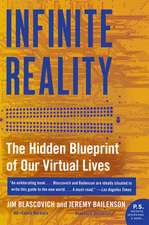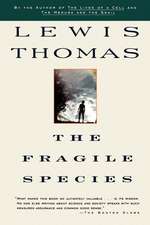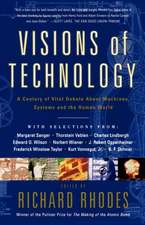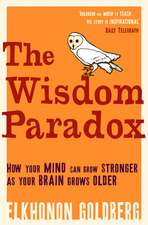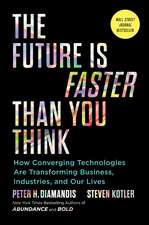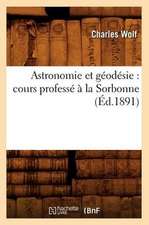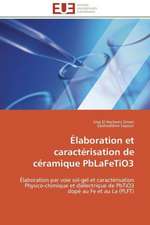Curing Cancer: The Story of the Men and Women Unlocking the Secrets of our Deadliest Illness
Autor Michael Waldholzen Limba Engleză Paperback – 7 sep 1999
Preț: 126.80 lei
Nou
Puncte Express: 190
Preț estimativ în valută:
24.26€ • 25.40$ • 20.08£
24.26€ • 25.40$ • 20.08£
Carte disponibilă
Livrare economică 15-29 martie
Preluare comenzi: 021 569.72.76
Specificații
ISBN-13: 9780684848020
ISBN-10: 0684848023
Pagini: 320
Ilustrații: 16 pps b-w insert
Dimensiuni: 140 x 216 x 20 mm
Greutate: 0.35 kg
Ediția:99000
Editura: Simon&Schuster
Colecția Simon & Schuster
Locul publicării:United States
ISBN-10: 0684848023
Pagini: 320
Ilustrații: 16 pps b-w insert
Dimensiuni: 140 x 216 x 20 mm
Greutate: 0.35 kg
Ediția:99000
Editura: Simon&Schuster
Colecția Simon & Schuster
Locul publicării:United States
Notă biografică
Michael Waldholz is a staff reporter at The Wall Street Journal. He is the coauthor, with Jerry Bishop, of Genome, a book based on their prizewinning Wall Street Journal series on the hunt for genes. Waldholz lives in Montclair, New Jersey.
Extras
1: A Mystery Solved
In 1993, sixteen years after his death, former Vice President Hubert H. Humphrey, or more accurately, a tiny part of him, participated in a remarkable experiment. Scientists in Baltimore, using new laboratory tools, solved a long-standing but little-known mystery surrounding the late politician's death. In doing so, the laboratory detectives uncovered information about Humphrey that might have changed the course of American politics in 1968.
But this experiment meant more than rewriting history; it revealed that science was in the midst of cracking open one of nature's deepest secrets: what causes cancer.
In their experiment, the scientific sleuths in Baltimore found the exact biological cause of the bladder cancer that killed Humphrey in 1978. The culprit was a tiny defect that somehow had taken hold in a single gene deep inside one of the numerous cells in Humphrey's bladder. The gene's job was to control the cell's growth. But because of the gene defect, which probably occurred early in Humphrey's life, the cell instead multiplied dangerously, over many years eventually expanding into a cell colony that is the hallmark of a cancerous and deadly tumor.
When Humphrey was diagnosed with cancer in 1971, and even when he died seven years later, nothing about this gene, not even the fact that it existed, was known. But in a series of insights in the 1980s and 1990s that turned cancer research upside down, scientists unmasked the identity of a handful of genes that work like master control switches, regulating the life cycle of a human cell. When these genes are somehow mutated, perhaps by some cancer-causing agent in the environment or by some internal mistake otherwise healthy cells outgrow their neighbors, by turn becoming unruly and rebellious. Suddenly, university biologists plumbing the arcane genetic machinery inside cells were thrust from relative obscurity into the worldwide war against cancer.
There is now reason to believe that in revealing these master switches scientists have finally found the answer to one of the greatest medical mysteries of the century: what turns a normal cell cancerous. The numerous advances that led scientists to this brilliant deduction were the result of tens of thousands of experiments, some dating back decades, whose findings became pieces of a gigantic puzzle finally put together, beginning in the late 1980s, by a relative handful of researchers. As a result, scientists the world over suddenly realize they have within their grasp the ability to search for totally new ways to detect, treat, and perhaps even someday cure cancer.
The Humphrey experiment was simply among the more dramatic and noteworthy illustrations of this new power. Indeed, the Baltimore scientists who undertook the experiment initially believed that publicizing it might draw the world's attention to the fact that, largely unseen, a breakthrough in understanding the genesis of cancer had occurred. Moreover, the scientists believed that the experiment heralded another fact: something new and powerful could now be done about the disease that reigns as one of mankind's most terrible scourges.
Humphrey, of course, was an icon of liberal American politics following World War II. In 1964, Lyndon Baines Johnson plucked Humphrey from the U.S. Senate to be his vice presidential running mate. In 1968, after Johnson declined to run for reelection and Robert F. Kennedy was assassinated, Humphrey was chosen by the Democratic party to run against the Republican choice, Richard M. Nixon. Humphrey, of course, lost to Nixon in one of the closest elections in American history.
But, unknown to Humphrey, his closest advisers, and the American electorate, a renowned physician at Johns Hopkins Hospital in Baltimore suspected that the candidate for president had a dangerous tumor growing inside him. The doctor, John D. (Jack) Frost, believed he held evidence of this extraordinary fact on a set of glass microscope slides which he had been sent to analyze. For two decades Frost stored the glass slides in his office desk drawer between two cardboard envelopes. The slides contained cells harvested from a urine sample given by Humphrey more than a year before he ran for the presidency.
In May of 1967, then Vice President Humphrey was concerned when he noticed several specks of blood in his urine. Within a few days, Humphrey's private physician quietly admitted the vice president to Bethesda Naval Hospital outside Washington, D.C. As part of the routine medical workup, the hospital's doctors took urine samples. Because of Humphrey's high office, several batches of the urine sample were placed on glass laboratory slides and shipped confidentially to several of the country's foremost cytopathologists, doctors who analyze individual cells under a microscope to determine by the way they look whether they are diseased.
Frost, director of the division of cytopathology at Johns Hopkins Hospital, believed some cells on his slides had undergone changes in shape and size characteristic of the very earliest stage of cancer. But most other experts apparently disagreed, and no treatment for cancer was recommended. Instead, doctors suggested that every six months Humphrey undergo a cystoscopy, a biopsy procedure in which a catheter is threaded through a patient's urinary tract into the bladder and cells are randomly extracted from the organ's inner walls. Although it is unclear what Humphrey was told, he then vigorously pursued the political path that led him to his historic fight against Nixon.
Two years later, one of the regularly scheduled biopsy exams found that cells removed from the bladder lining had definitely undergone some slight alterations. What exactly this meant was unclear. The alterations suggested the cells were in an early stage of cancer, but there was no evidence that they had invaded the bladder wall or posed a serious danger to Humphrey. Today, a number of therapies are available to treat the problem a type of tumor known as a carcinoma in situ.
Carcinomas of this type often are indolent, meaning they aren't a threat to grow massively or spread to other organs. But in 1969 the only way to excise the potentially dangerous tissue was through major surgery. Since the risk of surgery may have exceeded the danger posed by the carcinoma, no treatment was recommended for Humphrey. "The decision was made to just follow him," says Ralph H. Hruban, a pathologist at Hopkins drawn into the case later.
In 1973, another biopsy found evidence that the carcinoma had in fact perilously invaded the bladder wall, a strong hint it might be malignant. According to Humphrey's personal physician, Edgar Berman, the medical team on the case had 11 experts analyze the biopsied cells and give their opinions. Nine of them believed the tumor was benign but recommended radiation therapy anyway, one recommended doing nothing and one was so concerned that the tumor was already malignant that he recommended surgery to remove the entire bladder.
Humphrey, who by this time had rejoined the U.S. Senate, was administered a course of radiation and chemotherapy at Memorial Kettering Cancer Center in New York. The treatment failed to halt the cancer. In August 1976, after the tumor had spread beyond the bladder, the cancerous organ was finally removed. But it was too late. In January 1978, at age 66, Humphrey died of cancer at his home in Minnesota.
About eight years later, Jack Frost, the Hopkins pathologist, was sitting in his office with Ralph Hruban, an intern at the time. "I was looking at some specimens under a microscope," Hruban recalls, "And [Frost] called me over to his desk and said, 'Let me show you something that'll wiggle your ears.'" From his middle desk drawer, Frost pulled out a worn cardboard slide case identified simply on its cover with the words, "a patient of Dr. Berman."
Frost placed the slides under a microscope and told Hruban to take a look. "What do you make of it?" Frost asked.
"They look a little like cancer," Hruban replied, noting that the cells had degenerated, making the analysis difficult. "What am I looking at?" Hruban asked, his curiosity piqued.
"Those are slides from the late Hubert H. Humphrey," Frost said. "They were taken before he ran for president. I was certain they were cancerous then. I'm certain now."
In 1991, in a tragic coincidence, Frost died of lung cancer, a disease he had spent his career studying. Before he died, he was careful to hand the cardboard folder containing the intriguing slides to his wife, who passed them along to Frost's successor at the hospital, Yener S. Erozan. By then Hruban held a faculty position in the same department as Erozan. One of Hruban's projects was working with a small band of basic researchers at Johns Hopkins who were attracting attention in the scientific community for exploring one of the least understood regions of human biology: what transforms a normal, healthy human cell into a deadly tumorous cell.
Beginning in the late 1980s under the direction of a previously unheralded but brilliant investigator named Bert Vogelstein, the Hopkins group made a series of stunning discoveries showing that certain human genes inside the nucleus of a cell direct many aspects of cell growth. When these "growth-controlling genes" are somehow damaged, the Hopkins team revealed, cells divide rebelliously, over many years gathering into an abnormal storm of tissue, known as a tumor.
Soon after Frost died, one young member of Vogelstein's team, David Sidransky, published a landmark research paper. Sidransky believed his colleagues' gene discoveries might make possible an early-warning system for detecting a cancer. Sidransky thought that thousands of lives could be saved every year by detecting a cancer in its embryonic phase, long before it had grown large enough to be seen by x-rays or other conventional diagnostic techniques. When cancers are big enough to be seen by such traditional imaging methods, they often are already too vicious and too far along to cure. Sidransky set about searching for a way to identify in patients the genes that trigger the beginnings of colon cancer, the third most common cause of cancer death in the U.S., behind lung cancer and breast cancer.
Sidransky selected colon cancer because there was reason to believe that early-stage cancers shed cells into a person's stool, making it possible to collect and analyze cancerous cells without an invasive test. Using a complicated set of techniques pioneered in the laboratory of Bert Vogelstein, Sidransky compared the composition of growth-controlling genes in cells taken from a sample of a patient's tumor with genes in cells from the same patient's stool. To Sidransky's delight, he found that the same mutant gene in the patient's cancer could be detected in the patient's stool. In other words, the stool from patients with cancer of the colon contains small amounts of mutant DNA from the cancer, making it possible for the mutant DNA to be detected.
To Sidransky, the experiment meant that as the genetics of cancer continued to be unraveled, sometime soon doctors would be able to screen a healthy person's stool for a genetic clue that an unseen and otherwise undetectable tumor was sprouting in a patient's colon. Forewarned, a patient could be closely monitored for the early appearance of a full-blown tumor, which could then be surgically excised long before it became lethal. The gene test, he believed, might someday be as easy as having one's cholesterol or blood pressure measured.
"David's paper was inspiring to those of us dedicated to finding new, better ways to diagnose cancer early," Hruban says. "Since most therapy for cancer still fails against advanced forms of the disease, the key to successful cancer management is early detection. But current techniques really are far from acceptable."
Sidransky's report was the first time anyone had shown that the gene alterations that kick a colon cell into a cancerous mode could be identified in a sophisticated but still relatively simple way. "The paper gave us all sorts of exciting ideas," Hruban says. "But it also got me thinking about Jack [Frost], who only recently had died, and his old Humphrey slides. Suddenly, it hit me. I realized there now might be a way to prove, absolutely, whether Frost was right or wrong. It was a bit farfetched but I decided to work on it."
To do that he needed to duplicate Sidransky's experiment, this time analyzing bladder (not colon) cells. He needed to see if any of Humphrey's ancient cells contained a cancer-causing defect in its genetic machinery. But unlike Sidransky, Hruban would have to carry out his investigation on cells from a patient who had died years before, and whose medical records, tissue samples, and consent were not going to be easily assembled. Hruban first made certain the old Humphrey slides still existed, eventually tracking them to Frost's successor. "Dr. Erozan had them sitting in his drawer, just like Frost did," he says. Before Hruban even received the necessary family consent to rummage about Humphrey's old cells, he called Sidransky.
"I was intrigued," Sidransky says. "It was the kind of challenge I like. But I told Ralph there was nothing we could do unless we had samples of cells from Humphrey's actual tumor." It was in cells from the cancer that the Hopkins researchers might be able to find which of the newly discovered growth-controlling genes triggered the cancer. The scientists first had to identify the precise spot in the gene that was altered in the tumor cells and then look at the urine cells to determine if the same site was mutated there, too. Only then could the scientists say with confidence that a gene mutation detectable in the urine cells was the one that caused cancer in Humphrey's bladder.
It is a regular practice in research hospitals to save a one-quarter inch slice of a patient's tumor, and store it in a block of paraffin wax in a pathology department vault. If Humphrey had been treated in such a hospital, a square of wax containing a bit of the bladder tumor still existed. But where? Hruban decided to contact Humphrey's widow, Muriel, since she certainly would know if and where her late husband's tumor had been surgically removed. He also knew he needed her permission to poke about the late politician's medical history and molecular makeup. Hruban wrote her explaining his idea and asking for permission to proceed. He was surprised by the quickness of her reply.
"She was very interested," Hruban says. "She said Humphrey had a philosophy that something good always comes from life's difficulties. But until I had contacted her, she said the family had never found anything good from Humphrey's death. 'Maybe,' she said, 'this will be it.'"
Fortunately, the late senator's tumor had been removed at Memorial Sloan-Kettering. A bit of wax holding the tumor slice was retrieved from the pathology department's storage bins. A month after he first contacted Sidransky, Hruban was back at the molecular biologist's lab with Frost's old slides and a sample of Humphrey's tumor. Sidransky decided to scan the tumor cells for a mutation in the same gene he'd found mutated in his colon cancer experiment. The Hopkins scientists recently had found that, as with colon cancer, the gene sometimes was altered in bladder tumors, too. But the gene can be disrupted, or mutated, in many different ways. If the gene is compared to a 100-mile-long roadway, for instance, any pothole along the way can be a cancer-causing disruption. In order to conduct the experiment, Sidransky needed to find the exact mutation, or pothole, that occurred in Humphrey's cells. And this wasn't going to be easy because there were hundreds of possibilities.
The Sidransky lab's ability even to consider probing the intricate architecture of a gene was the result of astonishing strides in molecular biology, the field of science that studies the structure and functions of genes. Indeed, the Hopkins molecular biology labs and several hundred like them around the world were making discoveries about the nature of genes at a pace so rapid it was difficult even for scientists involved in the field to grasp. Bert Vogelstein, Sidransky, and their crews were part of a gigantic effort by "gene hunters" around the world to map the human genome, the entire complement of 100,000 or so genes that underlie human biology. Often referred to as the Human Genome Project, this global enterprise has led many scientific historians to predict that the end of the twentieth century and the opening decades of the twenty-first century will be known in the future as "the age of the gene."
The dawn of this new age of discovery can be traced back decades before the Humphrey experiment. Every gene is composed of the remarkable chemical at the center of life called deoxyribonucleic acid, or DNA, a fact revealed in a series of investigations in the 1940s. The secret of DNA, or how genes can control cell division, eye color, or even one's sex, was uncovered in 1953 in the famous double helix discovery by British physicist Francis Crick and his young American colleague, biologist James Watson. They found that the structure of DNA, and therefore every gene, resembles a spiraling molecular ladder. They showed that the ladder's outer twisting rails, or strands, are linked at regular intervals by steps or rungs. Each rung of this ladder consists of two molecules called base nucleotides, or simply "bases," that hang off each strand and are bound together like two squares of wood nailed side-by-side to form the ladder's steps.
There are four kinds of molecules or bases, A (for the molecule adenine), T (thymine), G (guanine), and C (cytosine). But these bases are dotted along the DNA ladder by the hundreds of millions. Scientists now know all 100,000 human genes lie in a regimented order along three feet of tightly coiled DNA amazingly packed into the tiny nucleus less than 1/1,000 of an inch wide at the center of every human cell. A gene's individual structure is determined by the order in which the four bases are aligned; each gene contains an average of 1,000 to 3,000 paired bases. Thus, a gene's structure is ruled by the precise sequence of its several thousand "base pairs."
The base pair sequence, then, is a set of instructions, a recipe of sorts, that instructs a cell on how to assemble a protein, the substance that carries out the activities of life. Proteins, in turn, are long twisted necklaces made up of simple amino acid molecules. Each amino acid is described by three of the gene's base "letters." The letters CTG, for instance, tell a cell to build the amino acid leucine and place it in a specific spot in a forming protein, while the sequence GAT describes aspartic acid. A cell laces together a protein's numerous amino acid components by systematically "reading" the gene's three-letter words, making each gene a kind of "sentence."
These proteins, such as enzymes and hormones, carry out the moment-to-moment activities of life. Insulin is a protein that cells manufacture to convert glucose in the bloodstream into the energy needed to keep a cell functioning. If some of the base pair letters of the insulin gene are somehow shuffled or missing, the insulin gene will be defective or mutated. A cell containing a defective insulin gene may be unable to build a correctly working insulin protein. It would, therefore, be unable to process blood glucose and that would result in diabetes. In research accumulated in the late 1980s and early 1990s, scientists began to show that damaged or missing proteins resulting from mutated genes are at the root of many common diseases, causing such health problems as heart attacks, Alzheimer's disease, arthritis, depression and, of course, cancer, in addition to diabetes.
Researchers discovered in the 1980s certain mutated genes can promote unwanted cell division, which they named "oncogenes," employing the Greek word "onkos," which means "mass." Scientists also found that cancer can arise if just one of the millions of cells clustered in an anatomical region, such as the inner wall of the bladder, contains mutated oncogenes. That's because mutated oncogenes can generate unwanted cell divisions and over time the offspring, each containing the identical gene mutation, can pile up into a cancerous colony.
When Sidransky analyzed colon cells that fell off the tumor into the stool of cancer patients, he searched the tumor cells for misspelled DNA "words" in the oncogene that would have resulted in a mutant protein. He synthesized a bit of DNA containing the garbled letters and used it as a genetic probe, much like a piece of Velcro that was able to attach itself to the same altered letters or mutation in the cells taken from the stool sample. If the jumbled gene letters in the tumor and stool cells matched precisely, he knew that some of the sloughed-off stool cells had originated in a colon tumor. They were like a fingerprint left behind by a criminal.
Soon after Hruban received Humphrey's original tumor specimen from Sloan-Kettering, Sidransky assigned Peter van der Riet, a young researcher in his lab, the task of looking for a mutation of another gene, called p53. This gene also was known to control cell growth. Indeed, Vogelstein and his colleagues had dubbed it a "tumor suppressor," because in its normal unaltered form, the gene kept cells from becoming cancerous. Moreover, in a series of experiments destined to make Vogelstein famous, his lab found that tumors for many types of cancer contained damaged versions of p53. One of those studies showed that mutant p53 often was present in bladder tumors. By the 1990s, scientists had unraveled the entire sequence of the thousands of base pair letters that make up the important protein-producing region of the p53 gene. When van der Riet laid out the sequence of letters in the p53 genes found in Humphrey's tumor cells and compared the sequence with those found in normal p53 genes, he found his quarry. One of the many thousands of adenine (A) base letters somehow had been replaced by a thymine (T), an absurdly minute but apparently disastrous substitution. The subtle change made the p53 protein unable to carry out its job of controlling the cell division of bladder cells.
The lab then turned to the 26-year-old cells on the slides stowed away for so long by Frost and his successor. If they found the exact same p53 defect in the urine cells, it would mean they had found the mutation that caused Humphrey's cancer. "The immediate challenge before us was whether we could retrieve enough intact DNA from the old cells to conduct a study," Sidransky says. The solution lay with another new lab technique that allows researchers to produce a thousandfold increase in a bit of DNA so slight it would otherwise be impossible to analyze. This laboratory amplification is what inspired Michael Crichton's best-selling novel Jurassic Park. It was this same copying tool that Crichton's fictional scientists used to reproduce dinosaurs from DNA stored for billions of years in prehistoric bits of amber. The same technique also made it possible for prosecutors in the O.J. Simpson murder case to generate large amounts of genetic material from tiny blood samples at the crime scene in order to conduct DNA "fingerprinting."
Fortunately for the Baltimore investigators, Humphrey's cells retained their original chemical composition. Once the cells were scraped off the slides, mixed in a variety of solutions, and then passed through the copying process, van der Riet was able to conduct his experiment. Within a few weeks of analysis, the lab found the telltale genetic fingerprint previously identified in cells extracted from Humphrey's bladder tumor. The match, the scientists agreed, was so precise that no other explanation existed: the cells on Frost's slides and the cells from the tumor embedded in the paraffin block had originated from the same deranged progenitor cells that had been growing in Humphrey's bladder in 1967. Frost had been right. It had taken a revolution in biology to prove it.
"We were bowled over," says Hruban. "Here at Hopkins we are well aware of the power of our gene discoveries and their potential for radically changing the diagnosis and treatment of cancer. But, pulling this [experiment] off required a great deal of luck, the exacting use of some very new technology, and an unusual commitment from the lab."
In a seminal research report published in the New England Journal of Medicine, the Hopkins team proclaimed their finding. "Remarkably, the cells harboring p53 mutations in his urine were detectable nine years before Humphrey underwent [surgery] . . . and six years before he received any therapy for bladder disease."
Moreover, the mutation of p53 told the researchers something else. New studies emanating from the Vogelstein labs strongly suggested that cancer cells with a p53 mutation were more likely to be aggressive, invading nearby tissue and spreading dangerously through the body. "[Mutant] p53 is a very bad character," Sidransky says. "We now know that even very small tumors containing a p53 mutant have very poor outcomes. When we see mutant p53 in an early stage cancer we know we must treat the cancer with very aggressive therapy. That's very powerful and important information for a patient and the treating doctor."
The p53 gene defect "raises the possibility," Sidransky and Hruban argued in their research paper, that Humphrey's cancer "was already in a phase of aggressive growth in 1967. had Humphrey known that he had aggressive bladder cancer in 1967, he might have withdrawn from the presidential race."
The news shook doctors who treated Humphrey. Dr. Willett Whitmore, who removed Humphrey's cancerous bladder at Memorial Sloan-Kettering in 1976, says Humphrey rejected his recommendation to have the surgery three years earlier when a biopsy revealed cancer spreading in his urinary tract. "If we knew that p53 was a factor, we could have twisted his arm," Whitmore says.
There is evidence that if Humphrey knew the danger he was in, he would have acted differently. After his disease became apparent, Humphrey told a biographer: "I would have resigned the nomination immediately [if] I knew of my illness."
But, for the practice of medicine, the Humphrey experiment had even broader implications. "The experiment showed definitively that we can pick up cancer years before the tumor is picked up by normal clinical methods," Dr. Sidransky says. "That's the real reason I was interested in conducting the experiment. The discovery that certain identifiable genes trigger cancer means that we now have in our hands the ability to screen people without symptoms and detect a cancer we wouldn't know existed. Patients whose cancers are found in an early, localized stage have a ninety percent chance of surviving at least five years. But if the cancer is detected after it has spread, the five-year survival rate drops to nine percent."
"We hoped by looking at Humphrey's cancer we would produce a dramatic way to publicize the power of this new technology," Sidransky says. "It's our belief that the public, including many doctors and hospitals, are unaware of the potential of these new [gene] findings, and that they soon can be harnessed to save the lives of thousands, perhaps millions, of people." When the experiment was conducted in 1993, Sidransky's lab had yet to develop techniques that would allow doctors to make routine use of such a test. But Sidransky and his colleagues at Johns Hopkins boldly proclaimed that soon -- perhaps by the end of the century -- a new era of "predictive medicine" in cancer would make gene tests as commonplace as biopsies, CT scans, MRIs and x-rays.
The Baltimore scientists are not alone in their enthusiasm. In the past several years, many of the world's most eminent basic scientists have come to believe there is no more dramatic, exciting, or important story in medicine than the hunt for the human genes, such as p53, that underlie cancer. There is reason to believe that in uncovering these genes scientists finally have found the key to cancer. Indeed, they already have used the key to open new door into cancer research, one that many scientists believe will lead them someday to cures.
In 1993 few people outside the biomedical science community were aware of the cancer gene story or its implications. Nonetheless, what is taking place in gene-hunting labs is truly momentous, involving a technology that may surpass atomic power or computers in its eventual effect on human life. But the cancer gene pursuit is more than great science. It is a compelling human saga involving a handful of dedicated scientists competing against one another to make tremendous advances, accompanied by immeasurable prestige and glory. There are stories of families tragically drawn into the annals of science because they are strangely haunted by deadly and mysterious illness common among their relatives.
Scientists now believe the genes that they are studying normally act as critical control switches deep within the core of every human cell, regulating the fragile, complex cycles of a cell's life by signaling the cell when to divide and when to stop dividing. Scientists are conviced that if these genes somehow become defective, normally well-behaved cells divide without check, eventually breaking loose and invading other tissues and organs.
This genetic scenario provides an entirely new and surprisingly simple model for understanding cancer, the most common, deadliest and baffling of diseases, killing more than one half million people in the United States each year. This scenario may prove to be the universal cause of cancer long sought by scientists. As the Humphrey experiment shows, these growth-controlling or tumor-suppressing genes already are providing novel diagnostic tools to accurately spot the presence of cancerous tumors so tiny that they previously evaded detection.
Until now, scientists were perplexed as to how and why a cancer arises. Scientists and doctors long have known that certain substances in the environment, such as toxic chemicals, gases, radiation or even certain kinds of diet, can be cancer-causing. But researchers are stumped as to why some people get cancer as a result of such exposure, while others don't. Why, for instance, will one longtime cigarette smoker develop lung cancer, while another won't?
At the same time, cancer doctors long have suspected, without proof, that a tendency to cancer can be inherited, passed along from parent to child. How else, they wondered, can the tragic clustering of cancers in some families be explained? Scientists guessed that an individual's susceptibility to, or defense against, cancer was the result of differences in genetic makeup, in a person's so-called inherited constitution. But scientists couldn't prove this idea because they had no way to identify the specific gene or set of genes that might vest someone with a vulnerability to cancer.
Now, the gene-hunting researchers say, they have the answer.
As a result of the recent gene discoveries, the scientists can now predict in some families who is born with an especially high risk of developing cancer and who is not. This feat has produced extraordinary human dramas. In 1994, in what scientists are hailing as one of the greatest gene discoveries so far, scientists in Utah found a gene that causes an inherited form of breast cancer. Researchers say that this gene, and others like it, is responsible for 7 to 10 percent of all breast cancer cases, perhaps affecting about 1 in 200 women. If true, that means that breast cancer is the most common lethal inherited disease yet uncovered, affecting many more people than such genetic diseases as cystic fibrosis, muscular dystrophy, hemophilia, or Down's syndrome.
The breast cancer gene research resulted from a tedious 20-year international search for large families where breast cancer was unusually common. Immediately, women in many of the research families were able to make use of the discovery. One woman in Great Britain was tracked down by British scientists. The scientists told the woman she was part of an extended-family whose members had cancer. A DNA test found that she very likely carried a defective form of the gene. Several days later she had a mammography that located the tiny beginnings of a tumor, which was removed. her doctors believe her prospects for full recovery are bright. "She had no reason to suspect she was at risk until we told her and she probably wouldn't have detected the tumor until it had grown dangerously large," her doctor says. He adds: "We're still pretty stunned by what's happened. It's as if we had a crystal ball and predicted the future."
Sometime in the future, scientists say, this kind of predictive cancer testing will be as common as tests that identify a person's risk of heart disease by measuring cholesterol. But scientists expect the gene findings to propel research even further, helping to create new, safer and more potent therapies designed to stop a cancer by literally turning off a tumor's malignant motor, perhaps by repairing or replacing the defective gene that causes the cancer. Already scientists have conducted laboratory tests in which they halted tumor growth by implanting a healthy version of a cancer gene into fast-dividing cancer cells. Several other experiments suggest that such "gene therapy" might reverse a cancer's course, shrinking potentially dangerous tumors. This represents a radical departure, for it embodies the kind of rational, directed treatment that cancer doctors long dreamed about.
Today, in addition to surgically removing a tumor, doctors battle cancer by bombarding cancer cells with toxic drugs or radiation, thus poisoning the cells to death. These noxious therapies seriously harm healthy tissue and make cancer patients severely ill. Worse, these therapies often fail to erase the cancer. The new cancer gene discoveries may change all that. By understanding the mechanism of a cancer cell at the genetic level, at the most basic inner workings of a cell, scientists are convinced they can tailor new medicines to interdict a cancer growth with precision and power unknown before. They argue, quite convincingly, that new gene-based therapies will someday make current toxic cancer treatments appear primitive, akin to the medical use of leeches or incantations in centuries past. Even the most cautious of gene hunters believe they finally are on the trail of crucial clues that may make it possible to conquer cancer.
Doctors aware of the quest for cancer genes say that even if cures are unavailing soon, the discoveries will produce powerful new ways to prevent the disease from occurring in the first place. The cancer gene theory suggests that each of us is born with a genetic profile that, once detected, can be used to predict our individual risk of carrying the seeds of our own destruction. Those found to be at unusually high risk may find they can dodge the cancer bullet by radically changing how they live, avoiding exposure to those things that can damage the genes, that cause the gene to become mutated.
But the power of this predictive information is also troublesome, because knowing about one's cancer fate without any cure can leave patients in a terrible quandary. Doctors and medical centers will need to create entirely new ways to counsel and treat patients and their relatives. Already, the tests being used in some research families are causing turmoil for health officials and scientists perplexed by what to do with this new knowledge. At what age, they wonder, should young girls in these breast cancer families be tested and notified of their cancer risk? Should scientists advise family members to keep their gene profiles hidden from health and life insurers, from employers, friends and relatives who may not understand the nature of the gene's power and the limitations of a gene test? Should the gene tests eventually be available for use by the general public? If so, who will pay for such testing and for the emotional and medical counseling that should accompany negative findings?
Certainly, whether they want it or are prepared for it, the day will soon come when insurers and employers will be flooded with new information about beneficiaries' and employees' cancer risks. Personal behavior and environmental and occupational health policy will be profoundly affected, as scientists use the gene discoveries to finally identify the precise external forces in our lives that trigger cancer by damaging certain genes.
To understand how far scientists have traveled toward this goal readers need only follow the cancer gene quest chronicled in the pages that follow. But this story is not only about a breakthrough in cancer. It is also about the nature of scientific inquiry in the closing days of the twentieth century and the people who conduct it. This particular scientific saga involves numerous people, but our portion of the tale will follow several actors whose roles are central to the narrative. They include a young feminist who dedicated almost 20 years to finding the essential clue to the most common and deadly of diseases among women; a mop-haired, born-again Christian whose competitive fire burns as intensely as his religious values; a computer whiz who bucked the scientific establishment with an unorthodox venture in order to fund his quest; and an ascetic Jew whose high school nickname was "Rock" and who, colleagues bet, will someday win the Nobel Prize. But for our purposes, the narrative begins with two sisters at a hospital in Michigan where a scientific discovery changed their lives forever.
Copyright © 1997 by Michael Waldholz
In 1993, sixteen years after his death, former Vice President Hubert H. Humphrey, or more accurately, a tiny part of him, participated in a remarkable experiment. Scientists in Baltimore, using new laboratory tools, solved a long-standing but little-known mystery surrounding the late politician's death. In doing so, the laboratory detectives uncovered information about Humphrey that might have changed the course of American politics in 1968.
But this experiment meant more than rewriting history; it revealed that science was in the midst of cracking open one of nature's deepest secrets: what causes cancer.
In their experiment, the scientific sleuths in Baltimore found the exact biological cause of the bladder cancer that killed Humphrey in 1978. The culprit was a tiny defect that somehow had taken hold in a single gene deep inside one of the numerous cells in Humphrey's bladder. The gene's job was to control the cell's growth. But because of the gene defect, which probably occurred early in Humphrey's life, the cell instead multiplied dangerously, over many years eventually expanding into a cell colony that is the hallmark of a cancerous and deadly tumor.
When Humphrey was diagnosed with cancer in 1971, and even when he died seven years later, nothing about this gene, not even the fact that it existed, was known. But in a series of insights in the 1980s and 1990s that turned cancer research upside down, scientists unmasked the identity of a handful of genes that work like master control switches, regulating the life cycle of a human cell. When these genes are somehow mutated, perhaps by some cancer-causing agent in the environment or by some internal mistake otherwise healthy cells outgrow their neighbors, by turn becoming unruly and rebellious. Suddenly, university biologists plumbing the arcane genetic machinery inside cells were thrust from relative obscurity into the worldwide war against cancer.
There is now reason to believe that in revealing these master switches scientists have finally found the answer to one of the greatest medical mysteries of the century: what turns a normal cell cancerous. The numerous advances that led scientists to this brilliant deduction were the result of tens of thousands of experiments, some dating back decades, whose findings became pieces of a gigantic puzzle finally put together, beginning in the late 1980s, by a relative handful of researchers. As a result, scientists the world over suddenly realize they have within their grasp the ability to search for totally new ways to detect, treat, and perhaps even someday cure cancer.
The Humphrey experiment was simply among the more dramatic and noteworthy illustrations of this new power. Indeed, the Baltimore scientists who undertook the experiment initially believed that publicizing it might draw the world's attention to the fact that, largely unseen, a breakthrough in understanding the genesis of cancer had occurred. Moreover, the scientists believed that the experiment heralded another fact: something new and powerful could now be done about the disease that reigns as one of mankind's most terrible scourges.
Humphrey, of course, was an icon of liberal American politics following World War II. In 1964, Lyndon Baines Johnson plucked Humphrey from the U.S. Senate to be his vice presidential running mate. In 1968, after Johnson declined to run for reelection and Robert F. Kennedy was assassinated, Humphrey was chosen by the Democratic party to run against the Republican choice, Richard M. Nixon. Humphrey, of course, lost to Nixon in one of the closest elections in American history.
But, unknown to Humphrey, his closest advisers, and the American electorate, a renowned physician at Johns Hopkins Hospital in Baltimore suspected that the candidate for president had a dangerous tumor growing inside him. The doctor, John D. (Jack) Frost, believed he held evidence of this extraordinary fact on a set of glass microscope slides which he had been sent to analyze. For two decades Frost stored the glass slides in his office desk drawer between two cardboard envelopes. The slides contained cells harvested from a urine sample given by Humphrey more than a year before he ran for the presidency.
In May of 1967, then Vice President Humphrey was concerned when he noticed several specks of blood in his urine. Within a few days, Humphrey's private physician quietly admitted the vice president to Bethesda Naval Hospital outside Washington, D.C. As part of the routine medical workup, the hospital's doctors took urine samples. Because of Humphrey's high office, several batches of the urine sample were placed on glass laboratory slides and shipped confidentially to several of the country's foremost cytopathologists, doctors who analyze individual cells under a microscope to determine by the way they look whether they are diseased.
Frost, director of the division of cytopathology at Johns Hopkins Hospital, believed some cells on his slides had undergone changes in shape and size characteristic of the very earliest stage of cancer. But most other experts apparently disagreed, and no treatment for cancer was recommended. Instead, doctors suggested that every six months Humphrey undergo a cystoscopy, a biopsy procedure in which a catheter is threaded through a patient's urinary tract into the bladder and cells are randomly extracted from the organ's inner walls. Although it is unclear what Humphrey was told, he then vigorously pursued the political path that led him to his historic fight against Nixon.
Two years later, one of the regularly scheduled biopsy exams found that cells removed from the bladder lining had definitely undergone some slight alterations. What exactly this meant was unclear. The alterations suggested the cells were in an early stage of cancer, but there was no evidence that they had invaded the bladder wall or posed a serious danger to Humphrey. Today, a number of therapies are available to treat the problem a type of tumor known as a carcinoma in situ.
Carcinomas of this type often are indolent, meaning they aren't a threat to grow massively or spread to other organs. But in 1969 the only way to excise the potentially dangerous tissue was through major surgery. Since the risk of surgery may have exceeded the danger posed by the carcinoma, no treatment was recommended for Humphrey. "The decision was made to just follow him," says Ralph H. Hruban, a pathologist at Hopkins drawn into the case later.
In 1973, another biopsy found evidence that the carcinoma had in fact perilously invaded the bladder wall, a strong hint it might be malignant. According to Humphrey's personal physician, Edgar Berman, the medical team on the case had 11 experts analyze the biopsied cells and give their opinions. Nine of them believed the tumor was benign but recommended radiation therapy anyway, one recommended doing nothing and one was so concerned that the tumor was already malignant that he recommended surgery to remove the entire bladder.
Humphrey, who by this time had rejoined the U.S. Senate, was administered a course of radiation and chemotherapy at Memorial Kettering Cancer Center in New York. The treatment failed to halt the cancer. In August 1976, after the tumor had spread beyond the bladder, the cancerous organ was finally removed. But it was too late. In January 1978, at age 66, Humphrey died of cancer at his home in Minnesota.
About eight years later, Jack Frost, the Hopkins pathologist, was sitting in his office with Ralph Hruban, an intern at the time. "I was looking at some specimens under a microscope," Hruban recalls, "And [Frost] called me over to his desk and said, 'Let me show you something that'll wiggle your ears.'" From his middle desk drawer, Frost pulled out a worn cardboard slide case identified simply on its cover with the words, "a patient of Dr. Berman."
Frost placed the slides under a microscope and told Hruban to take a look. "What do you make of it?" Frost asked.
"They look a little like cancer," Hruban replied, noting that the cells had degenerated, making the analysis difficult. "What am I looking at?" Hruban asked, his curiosity piqued.
"Those are slides from the late Hubert H. Humphrey," Frost said. "They were taken before he ran for president. I was certain they were cancerous then. I'm certain now."
In 1991, in a tragic coincidence, Frost died of lung cancer, a disease he had spent his career studying. Before he died, he was careful to hand the cardboard folder containing the intriguing slides to his wife, who passed them along to Frost's successor at the hospital, Yener S. Erozan. By then Hruban held a faculty position in the same department as Erozan. One of Hruban's projects was working with a small band of basic researchers at Johns Hopkins who were attracting attention in the scientific community for exploring one of the least understood regions of human biology: what transforms a normal, healthy human cell into a deadly tumorous cell.
Beginning in the late 1980s under the direction of a previously unheralded but brilliant investigator named Bert Vogelstein, the Hopkins group made a series of stunning discoveries showing that certain human genes inside the nucleus of a cell direct many aspects of cell growth. When these "growth-controlling genes" are somehow damaged, the Hopkins team revealed, cells divide rebelliously, over many years gathering into an abnormal storm of tissue, known as a tumor.
Soon after Frost died, one young member of Vogelstein's team, David Sidransky, published a landmark research paper. Sidransky believed his colleagues' gene discoveries might make possible an early-warning system for detecting a cancer. Sidransky thought that thousands of lives could be saved every year by detecting a cancer in its embryonic phase, long before it had grown large enough to be seen by x-rays or other conventional diagnostic techniques. When cancers are big enough to be seen by such traditional imaging methods, they often are already too vicious and too far along to cure. Sidransky set about searching for a way to identify in patients the genes that trigger the beginnings of colon cancer, the third most common cause of cancer death in the U.S., behind lung cancer and breast cancer.
Sidransky selected colon cancer because there was reason to believe that early-stage cancers shed cells into a person's stool, making it possible to collect and analyze cancerous cells without an invasive test. Using a complicated set of techniques pioneered in the laboratory of Bert Vogelstein, Sidransky compared the composition of growth-controlling genes in cells taken from a sample of a patient's tumor with genes in cells from the same patient's stool. To Sidransky's delight, he found that the same mutant gene in the patient's cancer could be detected in the patient's stool. In other words, the stool from patients with cancer of the colon contains small amounts of mutant DNA from the cancer, making it possible for the mutant DNA to be detected.
To Sidransky, the experiment meant that as the genetics of cancer continued to be unraveled, sometime soon doctors would be able to screen a healthy person's stool for a genetic clue that an unseen and otherwise undetectable tumor was sprouting in a patient's colon. Forewarned, a patient could be closely monitored for the early appearance of a full-blown tumor, which could then be surgically excised long before it became lethal. The gene test, he believed, might someday be as easy as having one's cholesterol or blood pressure measured.
"David's paper was inspiring to those of us dedicated to finding new, better ways to diagnose cancer early," Hruban says. "Since most therapy for cancer still fails against advanced forms of the disease, the key to successful cancer management is early detection. But current techniques really are far from acceptable."
Sidransky's report was the first time anyone had shown that the gene alterations that kick a colon cell into a cancerous mode could be identified in a sophisticated but still relatively simple way. "The paper gave us all sorts of exciting ideas," Hruban says. "But it also got me thinking about Jack [Frost], who only recently had died, and his old Humphrey slides. Suddenly, it hit me. I realized there now might be a way to prove, absolutely, whether Frost was right or wrong. It was a bit farfetched but I decided to work on it."
To do that he needed to duplicate Sidransky's experiment, this time analyzing bladder (not colon) cells. He needed to see if any of Humphrey's ancient cells contained a cancer-causing defect in its genetic machinery. But unlike Sidransky, Hruban would have to carry out his investigation on cells from a patient who had died years before, and whose medical records, tissue samples, and consent were not going to be easily assembled. Hruban first made certain the old Humphrey slides still existed, eventually tracking them to Frost's successor. "Dr. Erozan had them sitting in his drawer, just like Frost did," he says. Before Hruban even received the necessary family consent to rummage about Humphrey's old cells, he called Sidransky.
"I was intrigued," Sidransky says. "It was the kind of challenge I like. But I told Ralph there was nothing we could do unless we had samples of cells from Humphrey's actual tumor." It was in cells from the cancer that the Hopkins researchers might be able to find which of the newly discovered growth-controlling genes triggered the cancer. The scientists first had to identify the precise spot in the gene that was altered in the tumor cells and then look at the urine cells to determine if the same site was mutated there, too. Only then could the scientists say with confidence that a gene mutation detectable in the urine cells was the one that caused cancer in Humphrey's bladder.
It is a regular practice in research hospitals to save a one-quarter inch slice of a patient's tumor, and store it in a block of paraffin wax in a pathology department vault. If Humphrey had been treated in such a hospital, a square of wax containing a bit of the bladder tumor still existed. But where? Hruban decided to contact Humphrey's widow, Muriel, since she certainly would know if and where her late husband's tumor had been surgically removed. He also knew he needed her permission to poke about the late politician's medical history and molecular makeup. Hruban wrote her explaining his idea and asking for permission to proceed. He was surprised by the quickness of her reply.
"She was very interested," Hruban says. "She said Humphrey had a philosophy that something good always comes from life's difficulties. But until I had contacted her, she said the family had never found anything good from Humphrey's death. 'Maybe,' she said, 'this will be it.'"
Fortunately, the late senator's tumor had been removed at Memorial Sloan-Kettering. A bit of wax holding the tumor slice was retrieved from the pathology department's storage bins. A month after he first contacted Sidransky, Hruban was back at the molecular biologist's lab with Frost's old slides and a sample of Humphrey's tumor. Sidransky decided to scan the tumor cells for a mutation in the same gene he'd found mutated in his colon cancer experiment. The Hopkins scientists recently had found that, as with colon cancer, the gene sometimes was altered in bladder tumors, too. But the gene can be disrupted, or mutated, in many different ways. If the gene is compared to a 100-mile-long roadway, for instance, any pothole along the way can be a cancer-causing disruption. In order to conduct the experiment, Sidransky needed to find the exact mutation, or pothole, that occurred in Humphrey's cells. And this wasn't going to be easy because there were hundreds of possibilities.
The Sidransky lab's ability even to consider probing the intricate architecture of a gene was the result of astonishing strides in molecular biology, the field of science that studies the structure and functions of genes. Indeed, the Hopkins molecular biology labs and several hundred like them around the world were making discoveries about the nature of genes at a pace so rapid it was difficult even for scientists involved in the field to grasp. Bert Vogelstein, Sidransky, and their crews were part of a gigantic effort by "gene hunters" around the world to map the human genome, the entire complement of 100,000 or so genes that underlie human biology. Often referred to as the Human Genome Project, this global enterprise has led many scientific historians to predict that the end of the twentieth century and the opening decades of the twenty-first century will be known in the future as "the age of the gene."
The dawn of this new age of discovery can be traced back decades before the Humphrey experiment. Every gene is composed of the remarkable chemical at the center of life called deoxyribonucleic acid, or DNA, a fact revealed in a series of investigations in the 1940s. The secret of DNA, or how genes can control cell division, eye color, or even one's sex, was uncovered in 1953 in the famous double helix discovery by British physicist Francis Crick and his young American colleague, biologist James Watson. They found that the structure of DNA, and therefore every gene, resembles a spiraling molecular ladder. They showed that the ladder's outer twisting rails, or strands, are linked at regular intervals by steps or rungs. Each rung of this ladder consists of two molecules called base nucleotides, or simply "bases," that hang off each strand and are bound together like two squares of wood nailed side-by-side to form the ladder's steps.
There are four kinds of molecules or bases, A (for the molecule adenine), T (thymine), G (guanine), and C (cytosine). But these bases are dotted along the DNA ladder by the hundreds of millions. Scientists now know all 100,000 human genes lie in a regimented order along three feet of tightly coiled DNA amazingly packed into the tiny nucleus less than 1/1,000 of an inch wide at the center of every human cell. A gene's individual structure is determined by the order in which the four bases are aligned; each gene contains an average of 1,000 to 3,000 paired bases. Thus, a gene's structure is ruled by the precise sequence of its several thousand "base pairs."
The base pair sequence, then, is a set of instructions, a recipe of sorts, that instructs a cell on how to assemble a protein, the substance that carries out the activities of life. Proteins, in turn, are long twisted necklaces made up of simple amino acid molecules. Each amino acid is described by three of the gene's base "letters." The letters CTG, for instance, tell a cell to build the amino acid leucine and place it in a specific spot in a forming protein, while the sequence GAT describes aspartic acid. A cell laces together a protein's numerous amino acid components by systematically "reading" the gene's three-letter words, making each gene a kind of "sentence."
These proteins, such as enzymes and hormones, carry out the moment-to-moment activities of life. Insulin is a protein that cells manufacture to convert glucose in the bloodstream into the energy needed to keep a cell functioning. If some of the base pair letters of the insulin gene are somehow shuffled or missing, the insulin gene will be defective or mutated. A cell containing a defective insulin gene may be unable to build a correctly working insulin protein. It would, therefore, be unable to process blood glucose and that would result in diabetes. In research accumulated in the late 1980s and early 1990s, scientists began to show that damaged or missing proteins resulting from mutated genes are at the root of many common diseases, causing such health problems as heart attacks, Alzheimer's disease, arthritis, depression and, of course, cancer, in addition to diabetes.
Researchers discovered in the 1980s certain mutated genes can promote unwanted cell division, which they named "oncogenes," employing the Greek word "onkos," which means "mass." Scientists also found that cancer can arise if just one of the millions of cells clustered in an anatomical region, such as the inner wall of the bladder, contains mutated oncogenes. That's because mutated oncogenes can generate unwanted cell divisions and over time the offspring, each containing the identical gene mutation, can pile up into a cancerous colony.
When Sidransky analyzed colon cells that fell off the tumor into the stool of cancer patients, he searched the tumor cells for misspelled DNA "words" in the oncogene that would have resulted in a mutant protein. He synthesized a bit of DNA containing the garbled letters and used it as a genetic probe, much like a piece of Velcro that was able to attach itself to the same altered letters or mutation in the cells taken from the stool sample. If the jumbled gene letters in the tumor and stool cells matched precisely, he knew that some of the sloughed-off stool cells had originated in a colon tumor. They were like a fingerprint left behind by a criminal.
Soon after Hruban received Humphrey's original tumor specimen from Sloan-Kettering, Sidransky assigned Peter van der Riet, a young researcher in his lab, the task of looking for a mutation of another gene, called p53. This gene also was known to control cell growth. Indeed, Vogelstein and his colleagues had dubbed it a "tumor suppressor," because in its normal unaltered form, the gene kept cells from becoming cancerous. Moreover, in a series of experiments destined to make Vogelstein famous, his lab found that tumors for many types of cancer contained damaged versions of p53. One of those studies showed that mutant p53 often was present in bladder tumors. By the 1990s, scientists had unraveled the entire sequence of the thousands of base pair letters that make up the important protein-producing region of the p53 gene. When van der Riet laid out the sequence of letters in the p53 genes found in Humphrey's tumor cells and compared the sequence with those found in normal p53 genes, he found his quarry. One of the many thousands of adenine (A) base letters somehow had been replaced by a thymine (T), an absurdly minute but apparently disastrous substitution. The subtle change made the p53 protein unable to carry out its job of controlling the cell division of bladder cells.
The lab then turned to the 26-year-old cells on the slides stowed away for so long by Frost and his successor. If they found the exact same p53 defect in the urine cells, it would mean they had found the mutation that caused Humphrey's cancer. "The immediate challenge before us was whether we could retrieve enough intact DNA from the old cells to conduct a study," Sidransky says. The solution lay with another new lab technique that allows researchers to produce a thousandfold increase in a bit of DNA so slight it would otherwise be impossible to analyze. This laboratory amplification is what inspired Michael Crichton's best-selling novel Jurassic Park. It was this same copying tool that Crichton's fictional scientists used to reproduce dinosaurs from DNA stored for billions of years in prehistoric bits of amber. The same technique also made it possible for prosecutors in the O.J. Simpson murder case to generate large amounts of genetic material from tiny blood samples at the crime scene in order to conduct DNA "fingerprinting."
Fortunately for the Baltimore investigators, Humphrey's cells retained their original chemical composition. Once the cells were scraped off the slides, mixed in a variety of solutions, and then passed through the copying process, van der Riet was able to conduct his experiment. Within a few weeks of analysis, the lab found the telltale genetic fingerprint previously identified in cells extracted from Humphrey's bladder tumor. The match, the scientists agreed, was so precise that no other explanation existed: the cells on Frost's slides and the cells from the tumor embedded in the paraffin block had originated from the same deranged progenitor cells that had been growing in Humphrey's bladder in 1967. Frost had been right. It had taken a revolution in biology to prove it.
"We were bowled over," says Hruban. "Here at Hopkins we are well aware of the power of our gene discoveries and their potential for radically changing the diagnosis and treatment of cancer. But, pulling this [experiment] off required a great deal of luck, the exacting use of some very new technology, and an unusual commitment from the lab."
In a seminal research report published in the New England Journal of Medicine, the Hopkins team proclaimed their finding. "Remarkably, the cells harboring p53 mutations in his urine were detectable nine years before Humphrey underwent [surgery] . . . and six years before he received any therapy for bladder disease."
Moreover, the mutation of p53 told the researchers something else. New studies emanating from the Vogelstein labs strongly suggested that cancer cells with a p53 mutation were more likely to be aggressive, invading nearby tissue and spreading dangerously through the body. "[Mutant] p53 is a very bad character," Sidransky says. "We now know that even very small tumors containing a p53 mutant have very poor outcomes. When we see mutant p53 in an early stage cancer we know we must treat the cancer with very aggressive therapy. That's very powerful and important information for a patient and the treating doctor."
The p53 gene defect "raises the possibility," Sidransky and Hruban argued in their research paper, that Humphrey's cancer "was already in a phase of aggressive growth in 1967. had Humphrey known that he had aggressive bladder cancer in 1967, he might have withdrawn from the presidential race."
The news shook doctors who treated Humphrey. Dr. Willett Whitmore, who removed Humphrey's cancerous bladder at Memorial Sloan-Kettering in 1976, says Humphrey rejected his recommendation to have the surgery three years earlier when a biopsy revealed cancer spreading in his urinary tract. "If we knew that p53 was a factor, we could have twisted his arm," Whitmore says.
There is evidence that if Humphrey knew the danger he was in, he would have acted differently. After his disease became apparent, Humphrey told a biographer: "I would have resigned the nomination immediately [if] I knew of my illness."
But, for the practice of medicine, the Humphrey experiment had even broader implications. "The experiment showed definitively that we can pick up cancer years before the tumor is picked up by normal clinical methods," Dr. Sidransky says. "That's the real reason I was interested in conducting the experiment. The discovery that certain identifiable genes trigger cancer means that we now have in our hands the ability to screen people without symptoms and detect a cancer we wouldn't know existed. Patients whose cancers are found in an early, localized stage have a ninety percent chance of surviving at least five years. But if the cancer is detected after it has spread, the five-year survival rate drops to nine percent."
"We hoped by looking at Humphrey's cancer we would produce a dramatic way to publicize the power of this new technology," Sidransky says. "It's our belief that the public, including many doctors and hospitals, are unaware of the potential of these new [gene] findings, and that they soon can be harnessed to save the lives of thousands, perhaps millions, of people." When the experiment was conducted in 1993, Sidransky's lab had yet to develop techniques that would allow doctors to make routine use of such a test. But Sidransky and his colleagues at Johns Hopkins boldly proclaimed that soon -- perhaps by the end of the century -- a new era of "predictive medicine" in cancer would make gene tests as commonplace as biopsies, CT scans, MRIs and x-rays.
The Baltimore scientists are not alone in their enthusiasm. In the past several years, many of the world's most eminent basic scientists have come to believe there is no more dramatic, exciting, or important story in medicine than the hunt for the human genes, such as p53, that underlie cancer. There is reason to believe that in uncovering these genes scientists finally have found the key to cancer. Indeed, they already have used the key to open new door into cancer research, one that many scientists believe will lead them someday to cures.
In 1993 few people outside the biomedical science community were aware of the cancer gene story or its implications. Nonetheless, what is taking place in gene-hunting labs is truly momentous, involving a technology that may surpass atomic power or computers in its eventual effect on human life. But the cancer gene pursuit is more than great science. It is a compelling human saga involving a handful of dedicated scientists competing against one another to make tremendous advances, accompanied by immeasurable prestige and glory. There are stories of families tragically drawn into the annals of science because they are strangely haunted by deadly and mysterious illness common among their relatives.
Scientists now believe the genes that they are studying normally act as critical control switches deep within the core of every human cell, regulating the fragile, complex cycles of a cell's life by signaling the cell when to divide and when to stop dividing. Scientists are conviced that if these genes somehow become defective, normally well-behaved cells divide without check, eventually breaking loose and invading other tissues and organs.
This genetic scenario provides an entirely new and surprisingly simple model for understanding cancer, the most common, deadliest and baffling of diseases, killing more than one half million people in the United States each year. This scenario may prove to be the universal cause of cancer long sought by scientists. As the Humphrey experiment shows, these growth-controlling or tumor-suppressing genes already are providing novel diagnostic tools to accurately spot the presence of cancerous tumors so tiny that they previously evaded detection.
Until now, scientists were perplexed as to how and why a cancer arises. Scientists and doctors long have known that certain substances in the environment, such as toxic chemicals, gases, radiation or even certain kinds of diet, can be cancer-causing. But researchers are stumped as to why some people get cancer as a result of such exposure, while others don't. Why, for instance, will one longtime cigarette smoker develop lung cancer, while another won't?
At the same time, cancer doctors long have suspected, without proof, that a tendency to cancer can be inherited, passed along from parent to child. How else, they wondered, can the tragic clustering of cancers in some families be explained? Scientists guessed that an individual's susceptibility to, or defense against, cancer was the result of differences in genetic makeup, in a person's so-called inherited constitution. But scientists couldn't prove this idea because they had no way to identify the specific gene or set of genes that might vest someone with a vulnerability to cancer.
Now, the gene-hunting researchers say, they have the answer.
As a result of the recent gene discoveries, the scientists can now predict in some families who is born with an especially high risk of developing cancer and who is not. This feat has produced extraordinary human dramas. In 1994, in what scientists are hailing as one of the greatest gene discoveries so far, scientists in Utah found a gene that causes an inherited form of breast cancer. Researchers say that this gene, and others like it, is responsible for 7 to 10 percent of all breast cancer cases, perhaps affecting about 1 in 200 women. If true, that means that breast cancer is the most common lethal inherited disease yet uncovered, affecting many more people than such genetic diseases as cystic fibrosis, muscular dystrophy, hemophilia, or Down's syndrome.
The breast cancer gene research resulted from a tedious 20-year international search for large families where breast cancer was unusually common. Immediately, women in many of the research families were able to make use of the discovery. One woman in Great Britain was tracked down by British scientists. The scientists told the woman she was part of an extended-family whose members had cancer. A DNA test found that she very likely carried a defective form of the gene. Several days later she had a mammography that located the tiny beginnings of a tumor, which was removed. her doctors believe her prospects for full recovery are bright. "She had no reason to suspect she was at risk until we told her and she probably wouldn't have detected the tumor until it had grown dangerously large," her doctor says. He adds: "We're still pretty stunned by what's happened. It's as if we had a crystal ball and predicted the future."
Sometime in the future, scientists say, this kind of predictive cancer testing will be as common as tests that identify a person's risk of heart disease by measuring cholesterol. But scientists expect the gene findings to propel research even further, helping to create new, safer and more potent therapies designed to stop a cancer by literally turning off a tumor's malignant motor, perhaps by repairing or replacing the defective gene that causes the cancer. Already scientists have conducted laboratory tests in which they halted tumor growth by implanting a healthy version of a cancer gene into fast-dividing cancer cells. Several other experiments suggest that such "gene therapy" might reverse a cancer's course, shrinking potentially dangerous tumors. This represents a radical departure, for it embodies the kind of rational, directed treatment that cancer doctors long dreamed about.
Today, in addition to surgically removing a tumor, doctors battle cancer by bombarding cancer cells with toxic drugs or radiation, thus poisoning the cells to death. These noxious therapies seriously harm healthy tissue and make cancer patients severely ill. Worse, these therapies often fail to erase the cancer. The new cancer gene discoveries may change all that. By understanding the mechanism of a cancer cell at the genetic level, at the most basic inner workings of a cell, scientists are convinced they can tailor new medicines to interdict a cancer growth with precision and power unknown before. They argue, quite convincingly, that new gene-based therapies will someday make current toxic cancer treatments appear primitive, akin to the medical use of leeches or incantations in centuries past. Even the most cautious of gene hunters believe they finally are on the trail of crucial clues that may make it possible to conquer cancer.
Doctors aware of the quest for cancer genes say that even if cures are unavailing soon, the discoveries will produce powerful new ways to prevent the disease from occurring in the first place. The cancer gene theory suggests that each of us is born with a genetic profile that, once detected, can be used to predict our individual risk of carrying the seeds of our own destruction. Those found to be at unusually high risk may find they can dodge the cancer bullet by radically changing how they live, avoiding exposure to those things that can damage the genes, that cause the gene to become mutated.
But the power of this predictive information is also troublesome, because knowing about one's cancer fate without any cure can leave patients in a terrible quandary. Doctors and medical centers will need to create entirely new ways to counsel and treat patients and their relatives. Already, the tests being used in some research families are causing turmoil for health officials and scientists perplexed by what to do with this new knowledge. At what age, they wonder, should young girls in these breast cancer families be tested and notified of their cancer risk? Should scientists advise family members to keep their gene profiles hidden from health and life insurers, from employers, friends and relatives who may not understand the nature of the gene's power and the limitations of a gene test? Should the gene tests eventually be available for use by the general public? If so, who will pay for such testing and for the emotional and medical counseling that should accompany negative findings?
Certainly, whether they want it or are prepared for it, the day will soon come when insurers and employers will be flooded with new information about beneficiaries' and employees' cancer risks. Personal behavior and environmental and occupational health policy will be profoundly affected, as scientists use the gene discoveries to finally identify the precise external forces in our lives that trigger cancer by damaging certain genes.
To understand how far scientists have traveled toward this goal readers need only follow the cancer gene quest chronicled in the pages that follow. But this story is not only about a breakthrough in cancer. It is also about the nature of scientific inquiry in the closing days of the twentieth century and the people who conduct it. This particular scientific saga involves numerous people, but our portion of the tale will follow several actors whose roles are central to the narrative. They include a young feminist who dedicated almost 20 years to finding the essential clue to the most common and deadly of diseases among women; a mop-haired, born-again Christian whose competitive fire burns as intensely as his religious values; a computer whiz who bucked the scientific establishment with an unorthodox venture in order to fund his quest; and an ascetic Jew whose high school nickname was "Rock" and who, colleagues bet, will someday win the Nobel Prize. But for our purposes, the narrative begins with two sisters at a hospital in Michigan where a scientific discovery changed their lives forever.
Copyright © 1997 by Michael Waldholz
Cuprins
Contents
Preface
1: A Mystery Solved
2: Science Fiction
3: "Welcome to Chromosome 17"
4: Family 15
5: Trick or Treat
6: The Game
7: Cancer Families
8: Gold Mine
9: Guardian of the Genome
10: Ishmael's Tale
11: Clone by Phone
12: The Mother of All Tumor Suppressors
13: The Roller Coaster
14: Ras
15: First, Do No Harm
Epilogue
Acknowledgments
Notes
Bibliography
Index
Illustration Credits
Preface
1: A Mystery Solved
2: Science Fiction
3: "Welcome to Chromosome 17"
4: Family 15
5: Trick or Treat
6: The Game
7: Cancer Families
8: Gold Mine
9: Guardian of the Genome
10: Ishmael's Tale
11: Clone by Phone
12: The Mother of All Tumor Suppressors
13: The Roller Coaster
14: Ras
15: First, Do No Harm
Epilogue
Acknowledgments
Notes
Bibliography
Index
Illustration Credits
Recenzii
Andrea Cooper The New York Times Book Review Reads like an adventure story...as scientists search for the reasons a normal cell turns deadly.
Robert A. Weinberg Scientific American Engrossing...Waldholz offers rich fare -- up-close vignettes of several of the leaders in contemporary cancer research and how drive, ambition, and ample brain power have propelled their research and our understanding of this complex disease.
Publishers Weekly The story of cancer research unfolds with the intricacy of a fractal pattern and the human drama of a bestselling thriller.
Kirkus Reviews A...science reporter's colorful, people-centered account of the fierce competition among scientists to find the genetic causes of cancer.
Robert A. Weinberg Scientific American Engrossing...Waldholz offers rich fare -- up-close vignettes of several of the leaders in contemporary cancer research and how drive, ambition, and ample brain power have propelled their research and our understanding of this complex disease.
Publishers Weekly The story of cancer research unfolds with the intricacy of a fractal pattern and the human drama of a bestselling thriller.
Kirkus Reviews A...science reporter's colorful, people-centered account of the fierce competition among scientists to find the genetic causes of cancer.
Descriere
Reporting from the frontiers of research, an award-winning science writer brings readers the story of the people hunting for the genetic key to cancer, and the dramatic recent breakthroughs that offer hope for an eventual cure.

